City Know-hows

The foundation of children’s active lifestyles rests upon parents’ contentment with urban green spaces. This underscores the vital role urban planners and designers play in addressing parental concerns within these areas, thus amplifying children’s outdoor play and self-reliant exploration.
Share
Target audience
Urban planners,urban designers and child health specialists
The problem
Children allocate a significant portion of their time to urban public environments. In this regard, while urban green spaces have the potential to significantly shape children’s active lifestyles, insufficient attention has been given to the influence of parental perspectives regarding the attributes of these spaces. This gap in research hinders a comprehensive understanding of how parental perceptions can impact children’s engagement with urban green spaces and their overall physical activity levels.
What we did and why
The way parents view the qualities of urban green spaces (including safety, proximity, diversity, aesthetics, and cleanliness) showed a significant association with children’s outdoor play. Furthermore, safety and the proximity to urban green spaces emerged as crucial elements that positively contributed to children’s ability to move independently.
Our study’s contribution
In order for decision makers to take practical and effective measures, they must thoroughly evaluate the child friendly criteria using a range of assessment tools. This particular study is taking initial steps towards assessing the living environment of children in a practical manner that could help urban planners make more informed decisions.
Impacts for city policy and practice
Understanding parental viewpoints regarding urban green spaces stands as a pivotal determinant in fostering children’s physical activity. Thus, by acknowledging parental perceptions and desires related to these areas, urban planners and designers can create an environment that offers children a sense of comfort, thereby amplifying the potential for an active and healthful lifestyle. This collaborative approach not only benefits children’s well-being but also aligns with the broader goal of promoting healthier urban communities.
Further information
Full research article:
Related posts

The epigenome may provide a necessary link to advance knowledge of the biological pathways underlying the urban environmental impact on cognitive impairment and neurodegenerative disease risk. Broadening understanding of these pathways will help fuel multi-sectoral collaboration with decision makers to advance urban environmental health for human cognitive benefit.

Shared mobility hubs that offer (electric) bikes and cars can be a sustainable solution that enables people to expand their mobility options while protecting cities’ environment by reducing private car use and encouraging cycling. We interviewed residents of a deprived neighbourhood in Utrecht, the Netherlands, to understand their mobility needs and views on a recently implemented shared mobility hub in their neighbourhood, identifying potential obstacles in the process.

Although the CASE and MAPs were supposed to be temporary shelters for displaced persons, after fourteen years, they have not received proper maintenance and are dilapidated. This scenario opens to the idea that living in these places could negatively affect different psychological aspects, including perceived urban quality and environmental well-being.